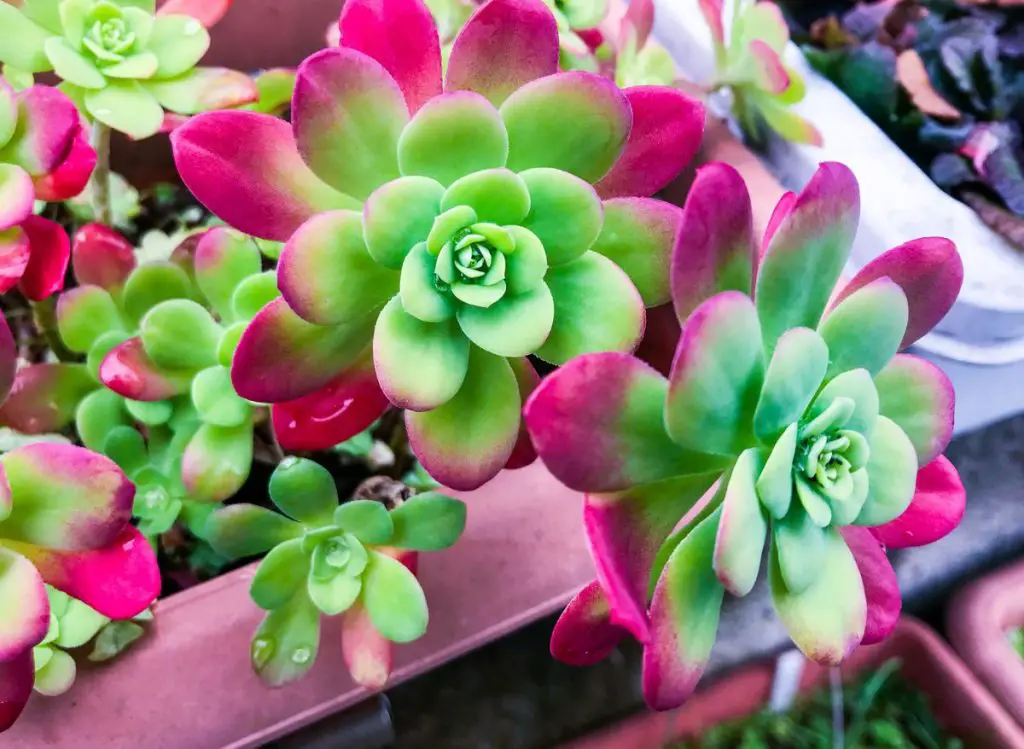Succulents are great plants that are known for their ability to retain water incredibly well. Because of this, they thrive indoors, in dry climates, warm regions, and much more. So even if you neglect these plants a little, they will still thrive.
Even after providing your succulents with proper care, you may notice a color change, which is entirely normal. Succulents are fascinating plants that can change based on the care they receive.
That is why many people opt for succulents to grow indoors, as they are low-maintenance plants. These plants often also change color. But why do succulents change color?
Succulents change color for various reasons. Here is a complete guide to understanding why this happens.
See also: How Long Can Succulents Live Without Water? (This long!)

3 Reasons Why Succulents Change Color
Here are the top reasons why succulents change their color:
1- Insufficient Sunlight Exposure
While succulents can thrive on a little neglect, they will need sunlight to grow well. For example, if you want to offer them an ideal growing situation, then you can provide them with the sun in the early morning and shade in the early afternoon.
An interesting thing about succulents is that if they don’t have enough sunlight, then they will conserve their energy by turning green.
On the other hand, if they get enough sunlight, then they will not stretch, but they might lose their color. That is why it is important for you to take care of your succulents in the correct manner that offers them enough sunlight and shade.
Succulents, including Aeonium, need bright sunlight to maintain their brilliant colors throughout the day.
plantsheaven.com
See also: Haworthia Fasciata And Attenuata: How to Differentiate The Two?
2- Over Watering Or Underwatering
If you water your succulent in the best way possible, they will lose their color and go back to a standard green. That is why if you are looking for succulents to be colorful, then you must not water them so often. For example, if you water your succulent at least once a week, you will notice a plain green color and foliage.
Instead, you can try watering the succulent after every two weeks. When you don’t water the plant, they have a tendency to become colorful. Generally, succulents have vibrant tips and foliage if you don’t water them so often.
3- Inadequate Temperature
Yes, the temperature also plays an important role in the succulent changing its color. Pink succulents are one of the top examples of this. For example, when the temperature stays above 40 degrees but drops below 70 degrees for a long time, then your succulents will turn a pinkish-red color.
Succulents, including Aloe, become colorful succulents in cold weather.
plantsheaven.com
Of course, that also depends on the variety of succulents you have in your home. As Spring comes near and the weather starts warming a little, then the colors will have less intensity. Finally, the color will not pop as much during the summer season as during winter.
See also: Top Indoor Succulents Low Light That Grow Well In Dark Room.
The Meaning Of The Changing Color Of Succulents
Succulents can change to various colors, such as pink, blue, purple, green, red, brown, yellow, and more. And, each color indicates something unique. You have to understand what it indicates and plan accordingly to get the best color you want for your plant.
Here are the most common succulent color changes and what they mean:
1- Blue Or Red Leaves
Your succulent leaves can easily turn purple, blue, orange, or red. If that is the case with your succulent, it means that your plant is stressed out. That is because when succulents are under high stress, they produce pigments known as carotenoid and anthocyanin.
These pigments prevent the succulent from suffering further damage. However, the result is some beautiful colors that you will love to see. For example, carotenoids can turn succulents yellow, orange, or red.
On the other hand, anthocyanin will turn your succulents purple or blue. Remember that a little stress can prove to be healthy for your succulent, which is why you don’t need to worry. If you see any sunburn damage or signs, then be sure to move your succulent towards some shade.
See also: Echeveria And Graptopetalum: What Are The Differences And Similarities?
2- Transparent Or Yellow Leaves
Yellow and soggy leaves are the top reason that your succulent is receiving too much water. That is because overwatering can kill your succulents, which is why you must understand the signs before they happen. If that is the case, take the succulent out of the container and leave it to dry for a few days.
After that, when you repot the succulent, then you must put it in soil that offers great drainage. Many times the succulent can also get waterlogged because the soil does not offer proper drainage. Besides that, you will also have to ensure an optimal watering schedule for your succulent that helps it to thrive.
See also: Best Ways Of Dealing With Splitting Lithops (Bes tips!)
3- White And Fuzzy Colored Spots
If you look at a white color on your succulents that is fuzzy and spotty, then it means you have a mealybug infestation. These mealybugs are fuzzy and white, but many people mistake them for fungus or mold. The ideal way to get rid of such an infestation is to quarantine the plant and use isopropyl alcohol as a spray on them.
It will not hurt your plant, and it will quickly get rid of the infestation. You can also research other ways if this does not work for your succulent.
4- Brown Leaves
Finally, succulents can also turn brown. Many people don’t like this color, and they want to avoid it as much as possible. However, succulents turning brown can be because of many reasons, which are hard to diagnose.
Brown leaves can happen because of sun damage, underwatering, overwatering, and more. That is why it can be frustrating to diagnose such a problem in your succulents.
So, you must try to understand what factors are affecting your plant to take steps to fix this issue.
See also: Echeveria And Aeonium: Which One Should You Choose?
Most Common Succulent Varieties
Succulents quickly become favorite indoor plants, thanks to their minimal care requirements. They also come in various colors, shapes, and sizes, making them ideal for every space and situation.
The table below shows the most common succulent varieties to add to your collection of plants
| Common Succulent Types | Characteristics | Best To Grow | Best Plants Companion For Succulents |
| Agave | – Plant Type: Succulent, perennial – Mature Size: depending on the variety, it can grow 1 to 20 ft. tall and 1–10 ft. wide – It grows well in sandy and well-drained – It requires full sun exposure – It thrives in acidic, neutral pH level – USDA Hardiness Zones: 5 to 11 | Outdoor | Not best for companion planting, but it will work well in landscaping. |
| Sempervivum “Hens and Chicks” | – Sempervivum can be easily propagated, and it quickly reproduces multiple offspring called “chicks – It requires full-sun exposure – Sempervivum mature size: 3 to 6 inches (8 to 15 cm). tall, 6 to12 inches (15 to 30 cm) wide. – Sempervivum grows well in sandy soil – Soil pH for Sempervivum is 6.6 to 7.5. – USDA Hardiness Zones: 3 to 8 | Outdoor | It is not recommended to pair Sempervivum with other succulents because of its ability to reproduce quickly. |
| Echeveria “Briar Rose” | – Echeveria “Briar Rose” is short-stemmed and easy to propagate through offsets and leaves. – Echeveria requires a potting mix that drains quickly. – USDA Hardiness Zones: 11 to 12 – Use the soak and dry method to water Echeveria. | Thrive both indoor and outdoor, but remember to bring it inside during harsh wintertime. | Echeveria works well with most other echeveria succulents, tiny cacti, and string varieties. |
| Echeveria ‘”Ruby” Plush | – Echeveria “Ruby” Plush grows up to 12 inches (30 cm) tall. – It is easily propagated by leaf cuttings | Grow well both indoors and outdoor, but don’t forget to bring it inside during winter. | Echeveria “Ruby” Plush can be grown with trailing and string varieties |
| Echeveria “Blue Bird” | – Echeveria “Blue Bird” can easily be propagated through offsets and leaves. | Grow well both indoors and outdoor; however, remember to bring it inside during winter. | Echeveria “Blue Bird” is perfect to use as a companion plant with other echeveria succulents, small cacti, and string types. |
| Aloe Vera | – Plant Type: Succulent, perennial, herbaceous perennial, and poisonous – It requires full sunlight exposure, at least six or more hours of direct sunlight a day, according to the North Carolina State University – It also does well in partial shade (2 to 6 hours) – USDA Plant Hardiness Zone: 10 to 12 | Aloe Vera can be grown indoors as a house plant or outdoor perennial in temperate zones. | Get along with most cacti varieties |
| Kalanchoe “Pink Butterflies” | – Kalanchoe “Pink Butterflies” is an incredibly colorful type of Kalanchoe. – It prefers warm temperatures and a few hours of daylight. – USDA Plant Hardiness Zone: 10 to 11. – Ideal temperature between 30 to 50 degree Fahrenheit ( – 1,1 to +10 celsius) | Kalanchoe “Pink Butterflies” thrives outdoor. | Kalanchoe “Pink Butterflies” is excellent for landscapes and in combination with other outdoor varieties. |
| Snake Plant | – Snake plant is generally toxic to dogs and cats. – It grows six inches to 8 feet tall and requires sandy and well-drained soil. – USDA Plant Hardiness Zone: 9 to 11. | Snake plant thrives indoors. | Not recommended for companion planting. |
| Jade Plant | – Jade Plant grows 3 to 6 ft. tall and 2–3 ft. wide – It thrives in full sun exposure and a well-drained soil – Jade Plant pH requirements: Neutral to acidic – drained soil. – USDA Plant Hardiness Zone: 11 to 12. | Jade plants can be planted indoors as houseplants or outside year-round in hotter regions. | Grow well in the company of string of tears, string of pearls, and other cascading varieties. |
| String of Pearls | – Trailing stems growing up to 3 feet long – String of pearls is ideal for hanging baskets – It is toxic to animals and children | It thrives both indoors and outdoor, but string of pearls should be brought inside during the winter. | String of pearls grows perfectly with most succulents. |
See also: How To Care For Succulents with Long Stems: Here’s how!
Final Words
That was everything you need to understand about why do succulents change color and what colors they can turn to. Many people like the vibrant colors, but you can always diagnose the problem and fix the issue so that your succulent can thrive. The good news is that succulent plant does not need much to thrive.
So, go through our guidelines and try to understand why your succulent is changing color. Once you have the reason, you can fix the issue and let your succulents thrive in optimal conditions in no time.



